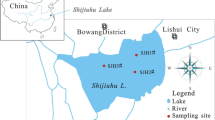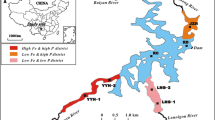Abstract
Phosphorus (P) is the main reason many surficial water bodies in the UK are currently failing to meet the chemical standards set by the Water Framework Directive (WFD). This work focuses on the role of sediments in the upper reaches of the River Taw in the South West of the UK. Point and diffuse sources of P have been identified as well as a number of mitigation measures applied or planned to address the issues. However, it is unknown what effect these sources have had on the river’s sediments and how they will react to diminishing inputs of P into the water column in the future. The diffusive gradient in thin-films (DGT) method is utilised in situ to quantify and identify labile, potentially bioavailable P fluxes and potential storage mechanisms at sites of known diffuse and point P inputs. In the vicinity of a heavily contaminated point source, data present here shows that sediments are still acting as a sink. The proposed mechanism for this is the formation of a ‘calcium cap’ which provides a geochemical barrier between the sediment and overlying water to prevent loss of labile P. The strong correlation between calcium and total P under most circumstances supports this hypothesis. This conclusion provides some confidence that even though P concentrations in some sediments are significantly elevated, mobility between the sediment and overlying water is restricted. In the context of routine monitoring against WFD targets, the molybdenum blue method generally employed to determine soluble reactive phosphorus was shown to not be equivalent to the DGT labile P pool, especially at pristine or moderately point/diffuse influenced sites. This is likely due to desorption of weakly bound P from colloids, which is unavailable to DGT devices. These results have the potential to be scaled up to the full catchment or other catchments which exhibit similar physical and chemical sediment composition and provide a stronger foundation for management and target setting than current monitoring approaches.




Similar content being viewed by others
References
Bowes MJ, House WA (2001) Phosphorus and dissolved silicon dynamics in the River Swale catchment, UK: a mass-balance approach. Hydrol Process 15(2):261–280
Collins AL, McGonigle DF (2008) Monitoring and modelling diffuse pollution from agriculture for policy support: UK and European experience. Environ Sci Policy 11(2):97–101
Comber S, Gardner M, Georges K, Blackwood D, Gilmour D (2013) Domestic source of phosphorus to sewage treatment works. Environ Technol 34(9–12):1349–58
Davison W, Zhang H (1994) In situ speciation measurements of trace components in natural waters using thin-film gels. Nature 367(6463):546–548
Davison W, Fones GR, Grime GW (1997) Dissolved metals in surface sediment and a microbial mat at 100-mu m resolution. Nature 387(6636):885–888
Davison W, Hooda PS, Zhang H, Edwards AC (1999) DGT measured fluxes as surrogates for uptake of metals by plants. Adv Environ Res 3(4):U14–555
Davison W, Zhang H, Warnken KW (2007) Theory and applications of DGT measurements in soils and sediments. Passive Sampling Tech Environ Monit 48:353–378
Degryse F, Smolders E, Zhang H, Davison W (2009) Predicting availability of mineral elements to plants with the DGT technique: a review of experimental data and interpretation by modelling. Environ Chem 6(3):198–218
Ding S, Xu D, Sun Q, Yin H, Zhang C (2010) Measurement of dissolved reactive phosphorus using diffusive gradients in thin films technique with a high-capacity binding phase. Environ Sci Technol 44:8169–8174
Environment Agency (2011) Waterbody Information Pack Taw Cluster. Environment Agency, May 2011
Evans DJ, Johnes PJ, Lawrence DS (2004) Physico-chemical controls on phosphorus cycling in two lowland streams. Part 2—the sediment phase. Sci Total Environ 329(1–3):165–182
Harper MP, Davison W, Zhang H, Tych W (1998) Kinetics of metal exchange between solids and solutions in sediments and soils interpreted from DGT measured fluxes. Geochim Cosmochim Acta 62(16):2757–2770
Harper MP, Davison W, Tych W (1999) Estimation of pore water concentrations from DGT profiles: a modelling approach. Aquat Geochem 5(4):337–355
Harper MP, Davison W, Tych W (2000) DIFS—a modelling and simulation tool for DGT induced trace metal remobilisation in sediments and soils. Environ Model Softw 15(1):55–66
He L-S, Liu H-l, Zhu Y-B, Xi B-D (2005) Phosphorus characteristics in leachate from soils irrigated with livestock wastewater. Huanjing Kexue 26(5):200–204
Jarvie HP, Neal C, Williams RJ, Neal M, Wickham HD, Hill LK (2002) Phosphorus sources, speciation and dynamics in the lowland eutrophic River Kennet, UK. Sci Total Environ 282:175–203
Jarvie HP, Jurgens MD, Williams RJ, Neal C, Davies JJL, Barrett C (2005) Role of river bed sediments as sources and sinks of phosphorus across two major eutrophic UK river basins: the Hampshire Avon and Herefordshire Wye. J Hydrol 304(1–4):51–74
Jarvie HP, Mortimer RJG, Palmer-Felgate EJ, Quinton KS, Harman SA, Carbo P (2008) Measurement of soluble reactive phosphorus concentration profiles and fluxes in river-bed sediments using DET get probes. J Hydrol 350(3–4):261–273
Lambert CP, Walling DE (1988) Measurement of channel storage of suspended sediment in a gravel-bed river. Catena 15:65–80
Liu J, Feng X, Qiu G, Anderson CWN, Yao H (2012) Prediction of methyl mercury uptake by rice plants (Oryza sativa L.) using the diffusive gradient in thin films technique. Environ Sci Technol 46(20):11013–11020
Mason S, McNeill A, McLaughlin MJ, Zhang H (2010) Prediction of wheat response to an application of phosphorus under field conditions using diffusive gradients in thin-films (DGT) and extraction methods. Plant Soil 337(1–2):243–258
Menzies NW, Kusumo B, Moody PW (2005) Assessment of P availability in heavily fertilized soils using the diffusive gradient in thin-films (DGT) technique. Plant Soil 269(1–2):1–9
Monbet P, McKelvie ID, Worsfold PJ (2008) Combined gel probes for the in situ determination of dissolved reactive phosphorus in porewaters and characterization of sediment reactivity. Environ Sci Technol 42(14):5112–5117
Monbet P, McKelvie ID, Worsfold PJ (2010) Sedimentary pools of phosphorus in the eutrophic Tamar estuary (SW England). J Environ Monit 12(1):296–304
Mundus S, Lombi E, Holm PE, Zhang H, Husted S (2012) Assessing the plant availability of manganese in soils using diffusive gradients in thin-films (DGT). Geoderma 183:92–99
Muscutt AD, Withers PJA (1996) The phosphorus content of rivers in England and Wales. Water Res 30(5):1258–1268
Neal C, Jarvie HP, Williams RJ, Neal M, Wickham H, Hill L (2002) Phosphorus-calcium carbonate saturation relationships in a lowland chalk river impacted by sewage inputs and phosphorus remediation: an assessment of phosphorus self-cleansing mechanisms in natural waters. Sci Total Environ 282:295–310
Österlund H, Chlot S, Faarinen M, Widerlund A, Rodushkin I, Ingri J (2010) Simultaneous measurements of As, Mo, Sb, V and W using a ferrihydrite diffusive gradients in thin-films (DGT) device. Anal Chim Acta 682(1–2):59–65
Palmer-Felgate EJ, Jarvie HP, Withers PJA, Mortimer RJG, Krom MD (2009) Stream-bed phosphorus in paired catchments with different agricultural land use intensity. Agric Ecosyst Environ 134(1–2):53–66
Palmer-Felgate EJ, Mortimer RJG, Krom MD, Jarvie HP (2010) Impact of point-source pollution on phosphorus and nitrogen cycling in stream-bed sediments. Environ Sci Technol 44(3):908–914
Reynolds CS, Davies PS (2001) Sources and bioavailability of phosphorus fractions in freshwaters: a British perspective. Biol Rev 76(1):27–64
Svendsen LM, Kronvang B, Kristensen P, Graesbol P (1995) Dynamics of phosphorus-compounds in a lowland river system- importance of retention and nonpoint sources. Hydrol Process 9(2):119–142
Tandy S, Mundus S, Yngvesson J, de Bang TC, Lombi E, Schjoerring JK (2011) The use of DGT for prediction of plant available copper, zinc and phosphorus in agricultural soils. Plant Soil 346(1–2):167–180
Van der Perk M, Owens PN, Deeks LK, Rawlins BG, Haygarth PM, Beven KJ (2007) Controls on catchment-scale patterns of phosphorus in soil, streambed sediment, and stream water. J Environ Qual 36(3):694–708
Withers PJA, Jarvie HP (2008) Delivery and cycling of phosphorus in rivers: a review. Sci Total Environ 400(1–3):379–395
Worsfold PJ, Monbet P, Tappin MF, Fitzsimons MF, Stiles DA, McKelvie ID (2008) Characterisation and quantification of organic phosphorus and organic nitrogen components in aquatic systems: a review. Anal Chim Acta 624(1):37–58
Zhang H. (2003) DGT–for measurements in waters, soils and sediments. DGT Research Ltd, Skelmorlie, Quernmore, Lancaster LA2 0QJ, UK
Zhang H, Davison W, Miller S, Tych W (1995) In-situ high-resolution measurements of fluxes of Ni, Nu, Fe, and Mn and concentraions of Zn and Cd in porewaters by DGT. Geochim Cosmochim Acta 59(20):4181–4192
Zhang H, Davison W, Gadi R, Kobayashi T (1998) In situ measurement of dissolved phosphorus in natural waters using DGT. Anal Chim Acta 370(1):29–38
Zhang H, Zhao FJ, Sun B, Davison W, McGrath SP (2001) A new method to measure effective soil solution concentration predicts copper availability to plants. Environ Sci Technol 35(12):2602–2607
Zhang H, Lombi E, Smolders E, McGrath S (2004) Kinetics of Zn release in soils and prediction of Zn concentration in plants using diffusive gradients in thin. Environ Sci Technol 38(13):3608–3613
Acknowledgments
The authors would like to thank the Westcountry Rivers Trust for funding this research and Hao Zhang from Lancaster University for supplying the DGT materials.
Author information
Authors and Affiliations
Corresponding author
Additional information
Responsible editor: Philippe Garrigues
Rights and permissions
About this article
Cite this article
Burns, E.E., Comber, S., Blake, W. et al. Determining riverine sediment storage mechanisms of biologically reactive phosphorus in situ using DGT. Environ Sci Pollut Res 22, 9816–9828 (2015). https://doi.org/10.1007/s11356-015-4109-3
Received:
Accepted:
Published:
Issue Date:
DOI: https://doi.org/10.1007/s11356-015-4109-3




